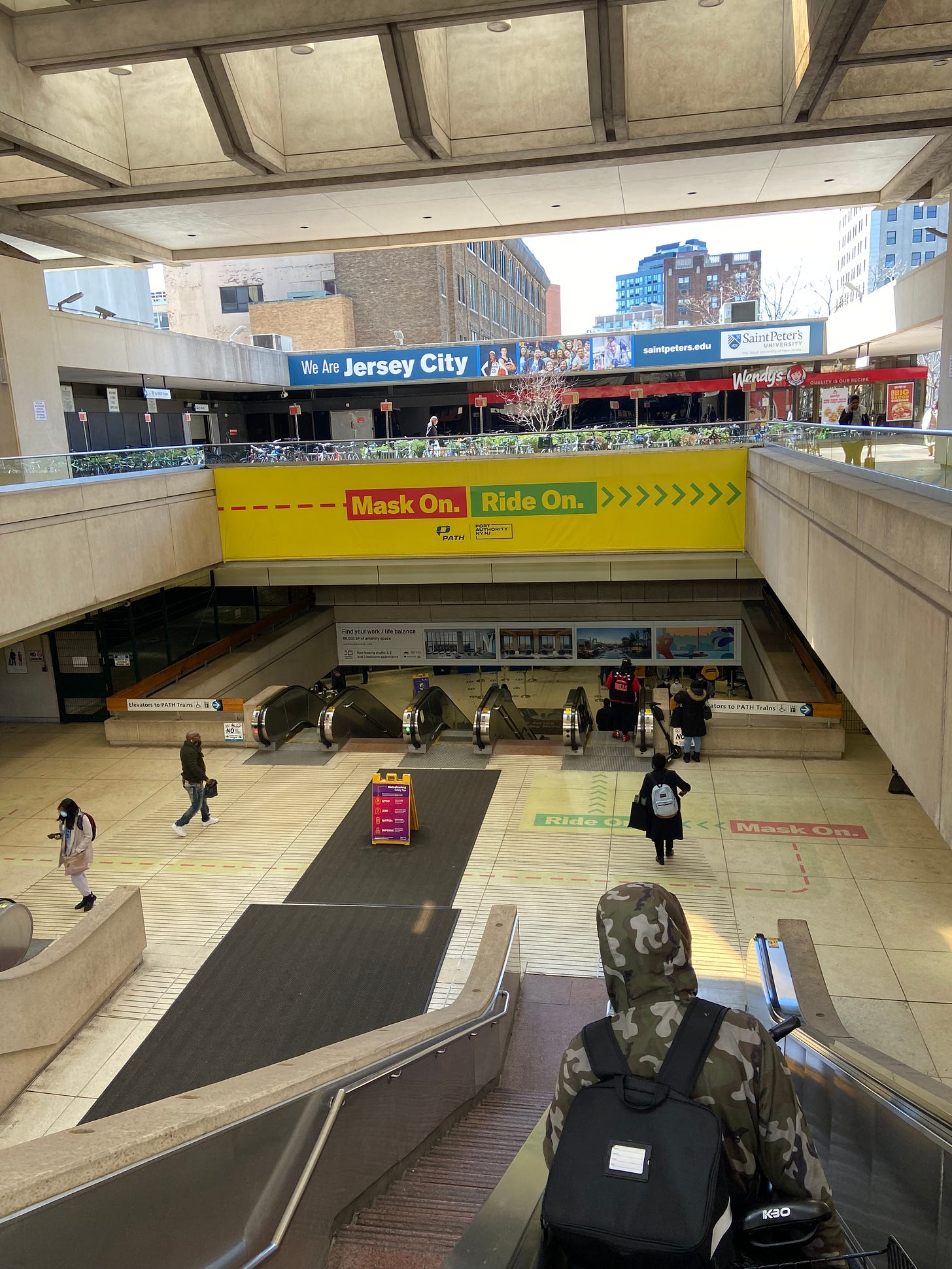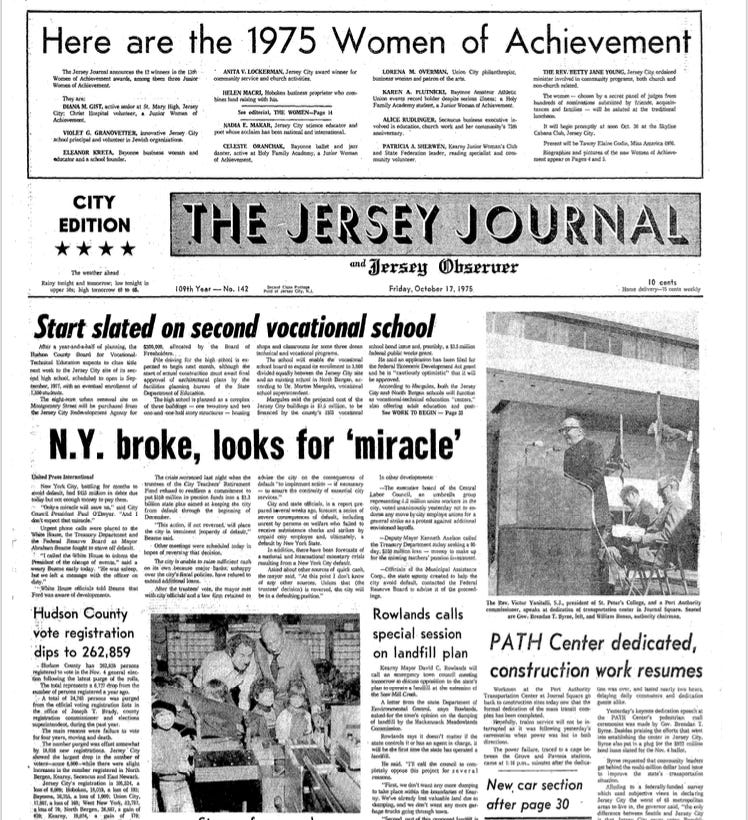Issue 53: the one that came out really, really late
Food poisoning! JSQ station, where you can find leprechauns, and more!
Hello! And my apologies for this issue being so late. I got horribly sick with food poisoning on Saturday, and one thing led to another and I missed the whole weekend. I’ve been desperately playing catch-up ever since, and you’ll see that reflected in this issue. Hope your week is going well, and see you on Sunday! — Amy
West Side rainbow
The most beautiful rainbow bloomed over the West Side about a week ago. I’m pretty sure the two ends of it are at St. Dominic’s Academy on JFK and Duncan Hardware on West Side, so if you’d like to go hunting for leprechauns those would be my first places to check.
Re-imagining the Journal Square Transportation Center
I’ve been thinking a lot about the Journal Square Transportation Center — that huge building in the center of the square that houses the PATH station and numerous buses, moving thousands of people to where they live and work every day. I’m quite fond of train stations in a very nerdy sort of way, with Grand Central Station being one of my favorite places on earth (Hoboken station too!). I’d be lying if I said that JSQ was somehow on par with either of those stations, even though I’m pretty fond of it as well. But all of this led me to wonder about the history of the station and to dig in a bit and wonder about what could make it better.
This is going to be the first part of a series about the station, where I’m going to really try to figure out what we can do to improve the station, to make it more usable and comfortable for all who pass through it. When you’re so used to passing through a place without thinking about it, it’s so easy to take things for granted — but all you have to do is try to help someone find the right bus they’re looking for or help someone disabled to maneuver the station to realize that things could be improved.
I decided to dig around a bit in the Jersey Journal archives to see what I could find out about the building from back when it was first dedicated, and it winds up the answer is “not much.” The building was built in stages between 1972-1975, and by the time it was officially dedicated in 1975, it must not have felt too exciting to locals because this is how the story appeared on the cover of the paper:
That’s it on the right hand side. I expected big, splashy coverage (“Come see the future of transportation!” etc) and was definitely disappointed by what it got instead — tucked beneath the Women of Achievement award and the construction of a new school, a very humdrum article.
Upon reading it, I think I discovered what may have dampened the enthusiasm for the new space:
Workmen at the Port Authority Transportation Center at Journal Square go back to construction sites today now that the formal dedication of the mass transit complex has been completed.
Hopefully, trains service [sic] will not be interrupted as it was following yesterday’s ceremonies when power was lost in both directions.
The power failure, traced to a cage between the Grove and Pavonia stations, came at 1:16pm, minutes after the dedication was over, and lasted nearly two hours, delaying daily commuters and dedication guests alike.1
Well, that’s not a great start.
The architectural style of the building is considered to be Brutalist — although it’s kind of “late” version of the style. Brutalism gets underway in the 1950s, and the whole point of it is to show off clean lines and bare materials — like the unpainted, raw concrete that makes up the majority of the building. It was the favored architectural style of British public housing for a while, and also proved very popular in Eastern Europe, including the former Soviet Union.
There are huge fans of this style of architecture — more on this in a moment. But it was favored so strongly for things like public housing because it was relatively quick to build and easy to maintain. The style is all about utility, first; decoration, dead last. It’s not the kind of architecture we normally associate with Jersey City, and it stands in contrast to things like the nearby Loew’s and Stanley Theaters.
Here’s the thing: I’m not a fan of the building, but I certainly do not think we should take any steps to replace it. But the trick with Brutalism is that this idea that it’s “easy to maintain” is kind of a lie. If you take a Victorian home and you allow it to rot away, it will still maintain some of its charm, perhaps taking on a spooky air. If you take an Art Deco building and let it just rust and fall apart… well, it will still be impressive, it might just look like it needs a good polishing and some work. But if you take a Brutalist structure and you allow the majority of the retail shops to fade away and the inside to get worn by use, there’s just not too much to look at once that happens. The minimal design starts to look a little less “on purpose,” and the feel of the building starts to be a bit hostile. (This is heightened in this particular station by the recent introduction of “anti-homeless” spikes that have been added all over any surface that might be comfortable for sitting.)
I decided to look into other, similar buildings to see what has been done to them to make them look their best. Here’s a few examples.
In the plans for the Tulum Train Station in Mexico you can see the interior being filled with plants — and check out those warm brown (wood?) benches circling where you can overlook the floor below, and those same warm notes being used for signage directing people to the trains, shops, etc. Note that this isn’t strictly a Brutalist station — because it’s being built now, it’s more of a “Neo-Brutalist,” but it’s still close:
If you look carefully at the picture of JSQ at the start of this section, you can see there’s some wood (just a tiny little bit, with signs pointing to the elevator) already incorporated into the landing right below street level. This could be a design element that could be extended elsewhere.
The use of wood and plants are common solutions to making Brutalist spaces seem just a little less brutal. I mentioned there are many huge fans of this style, and architect Pedro Reyes and fashion designer Carla Fernández are two such huge fans who live in a house in the style. But again, they use different elements to help soften the space:
Again, you can see the way that elements like wood and plants help to make the space feel softer and more livable.
Ok, but what if you don’t want to soften the space? What if you want it to look as hard and as sharp as possible? That’s a valid decision to make, but it will take consistency and planning to execute. As more retail moves in, there maybe a moment where considering what kind of signage, colors, fonts, etc the spaces can use. Asking a business to potentially restrict or change their branding is a tricky topic — it may be that adding plants and some wood elements is just easier in the long run. But if the desire is there to keep the space as “pure” as possible, that is also an option. The problem is, it’s halfway in-between right now, with the signage from the existing businesses clashing with the austere concrete.
In a future installment of this series, I’ll look into how including some art could really change up the space. But for now, I wanted to conclude with five (relatively) easy improvements that could be made almost immediately that would vastly improve JSQ station.
1. Clean the space.
Seriously. I don’t just mean mop the floors (which I can attest they do regularly). Powerwash the walls. Completely scrub down the plaza. JSQ Station really needs a serious deep cleaning from top to bottom. Upon doing so, the architecture of the space will look so much better and more purposeful.
2. Install new signage.
…to the bathrooms (see below), the businesses in the station, the elevators, the taxi stand, the buses (and explaining where the buses go/fares/schedules in a way that’s clear), but also to orient people getting off of the PATH and entering the Journal Square neighborhood. Remember that there are many ways to enter/leave the station, and that as a result we need a LOT of signs to guide people. (Making use of the abandoned kiosk in the Square could be incredibly helpful to this end, although I get that’s a big ask. Imagine if there was a person working there who could give out bus schedules and information on local businesses and that sort of thing.)
Jersey City as a whole first got wayfinding signage during the Cunningham administration; those signs, as far as I can tell, have not been updated since that time (which is why there’s still one announcing the placement of the JC Museum, even though the museum has been closed for over a decade). The signs are incredibly helpful and fit into the overall look of the city in a way that is pleasant and unobtrusive while still clear and easy to see. A similar design for the JSQ station could help unify the station with the city visually. (Or, if the PA wants to make it clear that you are on PA turf for whatever reason, a totally different design could help make that clear as well.)
3. Install garbage cans.
I know it’s hard to believe, but twenty+ years ago, we had garbage cans in the PATH stations. Then 9/11 happened, and all of them went away. I’ll say that in the immediate aftermath of that event, it made sense, given fears that terrorists were going to plant bombs in train stations. But here we are twenty years later and that has not happened, and most other stations have re-installed their garbage cans, even those in NYC.
The JSQ PATH station doesn’t have, as far as I can tell, a huge litter problem. However, this is part of making people who are taking the train feel more welcome and more comfortable on their commute. It’s a tiny thing — but it makes a big difference to people passing through the space.
4. Keep the bathrooms open longer.
This one actually makes me pretty angry. Free, accessible bathrooms should be everywhere — they’re imperative for many passengers who are disabled/not feeling well/elderly/pregnant/new parents, and they just make life more pleasant for everyone else.
Here’s a kind of gross truth when it comes to city planning: if you don’t make public bathrooms available, people will simply relieve themselves wherever they can. This happens in high income neighborhoods and in low income neighborhoods — human beings need bathrooms. And I can tell you that there are no nearby restrooms available — none of the fast food places on the upper level have bathrooms available to the public, and you’d have to walk over to Emma’s and order a meal before you could get to use theirs.
I’ve already started a conversation with a few people at the station about what it would mean to fix this situation, and I’ll follow up with that in a later segment. But I wanted to list this as one of the imperatives of getting the station to where it needs to be.
5. Make the station the kind of place where you could sit for a moment, get your things together before you travel, or meet someone getting off the train.
Ok, this could be the eventual conclusion of this project, or this could be a mid-way point — I’m choosing to see it as the latter. For now, let’s make the station the kind of place where hanging around for a little bit is comfortable; later, we can talk about making it the kind of place you might want to spend an afternoon (maybe). And to that end: install at least some benches, and remove the “hostile” spikes that line various flat surfaces. Put aside the inhumanity and cruelty of denying someone who is homeless a simple place to sit; the spikes that have been installed also deny people who are not homeless a place to arrange their belongings and get out a metro card before entering the station, or to sit with a fussy baby for a moment or collapse a stroller, or to grab a quick snack before boarding the train. Meeting a friend at the station? Your only choice is to stand.
So what is it going to take to get some improvements — maybe some of the ones I listed above, maybe others — in the station? Journal Square station is run by the Port Authority, not the City of Jersey City, and as part of this series, I want to look into what it will take to make change. The station has been pretty much the same since that faithful day it was dedicated, only luckily now the power tends to stay on. Maybe, with all the changes coming to Journal Square, we can get some improvements to this station that will make all of our lives more comfortable and easier to navigate.
***
Postscript: Hey wait a minute, I thought you were against gentrification?
I am. But there’s a big difference between gentrification and a necessary improvement. To my mind, if we tore down the existing structure and replaced it with a shiny, brand new building, with corridors perfectly and seamlessly leading from the newer constructions to the train, or from the train to the Pompidou, that would be gentrification. Helping people who already live here figure out what bus to take isn’t gentrification — that’s courtesy and consideration, along with a side order of encouraging people to take public transportation. If executed correctly, these improvements would help make the station better for everyone in JC, not just a coveted minority, as in the case of gentrification.
Have ideas to make JSQ Station better? Respond to this email!
Perpetual ask!
Hey there! JCMAS is always very eager to take excess diapers off your hands if you’ve over-bought for your baby. Ever stock up at Costco just to have your baby suddenly experience a growth spurt? Or maybe you had a baby shower and got tons of NB diapers but gave birth to a Size 1 baby (this happens often!). We are happy to take those diapers, repackage them, and give them to a family in need. With many COVID protections ending, we’re experiencing increased demand for assistance. Just fill out the form at the bottom of this page and we will schedule a time to pick up from you!
Printing out and/or sharing this image below is also greatly appreciated!
ICYMI
You can buy recreational weed in NJ starting this Thursday!!! Yes, that’s 4/21, not 4/20 (look, the state is trying to play it off like “we meant to do that!” but my guess is they didn’t — some random guy in Trenton fished that date out of a hat, having no idea that 4/20 is a stoner holiday. But whatever!). But not in Jersey City, unfortunately.
So here’s a list of the places that are supposed to be ready by Thursday BUT — and this is a huge BUT — call or check with them first that they’re really going to be doing recreational sales before you head out. The list has changed a few times and who knows what will happen before Thursday.
Also, I just want to put out there that these legal places will be selling flower for about $60 for an 1/8th, which is twice the price you can usually get it on the black market. Plus side: it will be great quality, and if you don’t have a connection to it otherwise, this can be very helpful. And also it’s legal! But if you’re used to buying off a friend who knows someone, prepare for some sticker shock.
There’s also a great quote a couple of paragraphs later that I just have to include:
Alluding to a federal-funded survey which used subjective views in declaring Jersey City the worst of 65 metropolitan areas to live in, [Governor Byrne] said, “the only difference between Seattle and Jersey City is that Jersey City never votes Republican.”
Erm, ok.









